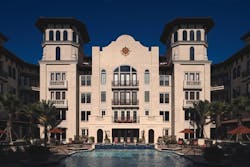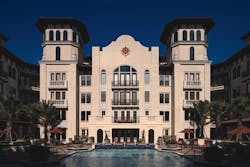Attracting the Next Wave of Renters
The crippling mortgage crisis in the United States has had an increasingly obvious and devastating effect on the single-family housing market. While the escalating number of home foreclosures has landed a blow on the U.S. economy, a profoundly different impact is being felt in the multi-family housing industry. According to a July 2007 survey by the Washington, D.C.-based National Multi Housing Council (NMHC), 55 percent of apartment executives said that the subprime mortgage meltdown and stricter mortgage credit had decreased the number of renters leaving apartments to become homeowners. In January 2008, just 6 months later, that number had jumped to a startling 79 percent.
What can you do in such an unsteady economy to secure your part of the surging pool of renters? "Exceed expectations," says Art Lomenick, managing director at Dallas-based Trammell Crow Co. and president of its High Street Residential subsidiary. Knowing your target markets, researching and providing top amenities, and providing renters with attentive customer service are sure ways to make your multi-family facility stick out in a renter's market.
Who's Renting?
Knowing who renters are and what they expect will help you fulfill their needs. "Successful marketing of your community occurs when you understand who your target market is, where they work, where they live, and where they play," says Pam McKenna, portfolio manager for Portland, OR-based Guardian Management.
While target renter markets vary by type of building and location, two distinct groups stand out in today's rental environment. According to the NMHC's Restoring the Balance report, more than 1 million households became renters between 2004 and 2006, and that number is projected to jump to 4.3 million households over the next decade. The key renters in these figures are "Echo Boomers" (those born between 1977 and 1994) and "Millennials" (those born during and after 1995). Sophisticated consumers of technology, bred with high expectations, these young renters want high-tech, green, and walkable urban communities and apartments.
Other important renters include the households and young families affected by the mortgage crisis. Instead of moving to their first single-family home, many families that can't qualify for housing loans, or that are worried about getting caught in the mire of a falling market, are remaining in or seeking out multi-family housing options. Facilities that appeal to residential and family-friendly tastes are going to be more and more important in the months and years ahead. "Many of these renters are seeking out stability in housing after the instability of rising mortgage payments and fees," says Jill C. Keoppel, 2008 board president for the Portland, OR-based Metro Multifamily Housing Association and senior portfolio manager at Income Property Management Co., also in Portland, OR. "They hope to find not just a place to stay, but a home, which includes the amenities typically found in a single-family home."
Evolving Amenities
Convenience is king for the spectrum of renters. To attract the key renter markets, multi-family building owners must cater to the needs and wants of increasingly busy people. Washers and dryers in each unit, or at least on the premises, are must-haves. Dishwashers, full kitchens, and garages also appeal to families and former homeowners. The tech-savvy Echo Boomers' lifestyles and work situations require WiFi and high-speed Internet throughout the complex. Lomenick also adds that an increasingly important amenity "is a really good health club, or at least association with a great health club."
For businesspeople and on-the-go families, having all needs met in one location is ideal, which is why multi-family housing units in mixed-use communities are rising in popularity and demand. "Mixed-use properties tend to be more resilient to market swings," says Lomenick. While renters will always want to live close to work or transportation, some may be more willing to live away from the heart of downtown or commute a little bit if their home base meets all their needs within a walkable distance. McKenna suggests offering personal trainers, dance and yoga classes, walking groups, and book clubs to enrich the community atmosphere of your multi-family housing complex.
"Renters are seeking a neighborhood feel and a sense of community with the people around them," agrees Keoppel, who also points out the benefits of having ample grounds and yards for each unit. "For those who once had a yard [or are seeking a single-family home environment], green space is a priority," she says. If there isn't enough green space for individual yards, McKenna suggests community gardens, where residents can plant their own vegetables or flowers.
Green amenities like this will definitely attract the next generation of renters. "Green living has become an important part of what renters are looking for," says McKenna. "Recycling programs are not enough to attract today's eco-friendly renter. Providing free green-cleaning products in refillable bottles, utilizing green vendors, organizing community-outreach programs for residents, and installing recycled flooring, low-flow toilets, and energy-efficient appliances ... these are some of the many ways you can improve the appeal of your community."
The green message of your apartment building ties directly into cutting down on greenhouse-gas emissions, so think about what you will do regarding transportation to and around your facility. "Being near transit and a multi-modal source of transportation is going to be a huge issue when people are deciding where they should live," says Lomenick. The importance of location moves up the list as gas prices continue to rise. "Potential renters are looking inward and are increasingly going carless," says Keoppel. If your apartment building isn't close to major transportation, consider helping your tenants go carless: Provide car-sharing services, such as Zipcar, or offer a shuttle from the complex on a planned schedule.
Low-Cost Solutions
If your building's budget can't stomach free transportation, personal trainers, and cyber cafés, don't worry—there are plenty of low- and no-cost options available that can transform your buildings, both inside and out.
"Paint is the easiest way to improve curb appeal. It can have such an impact on your community," says McKenna. "If your budget doesn't allow for an extensive paint job, consider painting the trim in a new color, or painting an accent color that will call out your building's architectural design." Of course, she adds, "the most cost-effective way to improve your curb appeal is to keep it clean." Make sure parking lots are clear of debris, and ensure that curbs and speed bumps are power washed and painted annually. Also think about revamping signage. "Does it scream, ‘I'm from the ‘80s'?" she asks. "It might be time to look into options for adding detail to the current signs or purchasing new ones." She also suggests working with your landscape maintenance company to ensure that grass edges are clean lines.
"Landscaping is often a fairly inexpensive way to attract former homeowners," says Keoppel, who suggests using bark dust/wood mulch and potted plants for a fresh look. "Beautiful flowers can really make a building stand out," McKenna agrees. Lomenick also advises using plants to spruce up a space. "A constant rotation of seasonal colors and fresh pots [is] probably the top thing you can do that's inexpensive in the grand scheme of things," he says.
Ask Your Tenants
Above all, the easiest and least expensive way to attract and keep renters is professional, personalized customer service. Lomenick encourages a resort-like attentiveness to how your buildings are managed. "Don't wait for customers to want something," he says. "As a property manager, go in and say, ‘We're going to facelift an appliance for you,' or ‘We're going to paint your living room. Pick a color.' " Make your tenants feel attended to and valued. "They should never think, ‘Well, I signed a lease and now I'll never see them again.' "
To anticipate what your renters will want, do your homework. "Surveys are the best way to focus on what [you] can do to improve the renter's experience," says McKenna. "The first survey should be given the day they move in." After your tenants have been in the building for a while, ask them what they think about how you're doing as a property manager. Keoppel suggests asking tenants the following questions:
-
Does management maintain the grounds and public areas to your satisfaction?
-
Are repair requests responded to in a timely and professional manner?
-
Are there any issues you feel need to be addressed to ensure peaceful enjoyment and livability?
-
What do you like best about living here?
Keoppel's organization also conducts exit surveys with its tenants to see what, if anything, could've been done better. If you're not inspired by surveys, try involving the residents in a more direct way. "The best thing that has worked for us is resident advisory panels," says Lomenick. "People feel like they're part of a community that way. You have maybe a dozen residents, and you can get pure, real-time feedback." Lomenick encourages incentives for members of the panels. "Make it fun for them," he says. "Every meeting could be a happy hour, or members could get $100 off their rent for 1 month," he suggests.
Plan for the Future
This year has seen the lowest homeownership rate in 5.5 years. But, just because the demand for apartments remains strong doesn't mean that multi-family housing isn't feeling the pinch. The continued credit crunch is decreasing property sales and making it harder for apartment firms to access debt and equity markets, says the NMHC in its May 2008 Quarterly Survey of Apartment Market Conditions. This, coupled with the "shadow market" of rental homes and condos now being offered for rent by individuals who can't afford to live in them anymore, can potentially damage the demand for professionally managed apartments.
Organizations like the NMHC or the Arlington, VA-based National Apartment Association can be an excellent way to gain access to information on trends and the state of the industry. You've got to stay on top of the game to attract good tenants. "The next wave of renters is smart," says McKenna. "They are wired in and are looking for a process that's easy and entertaining, and yields quick results." Perfecting your customer service and anticipating the needs and wants of renters will help you hold firm in an unsteady economy.
|
Expert Advice Buildings magazine asked the experts: What is your top piece of advice for professionals who own or manage multi-family housing properties? "Provide convenience through location, public transportation, shopping, or green space. Mixed-use buildings have strong appeal." - Jill C. Keoppel, 2008 Board President, Metro Multifamily Housing Association, Portland, OR "You need to be an expert in your market and know what your community has to offer." - Pam McKenna, Portfolio Manager, Guardian Management, Portland, OR "Start concentrating on how to integrate rental communities into the walkable environment. Help reinvent the suburbs - that's what will help future renters." - Art Lomenick, Managing Director, Trammell Crow Co., Dallas |
Jenna M. Aker ([email protected]) is new products editor at Buildings magazine.

